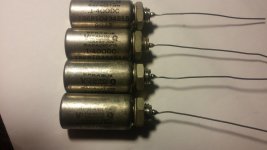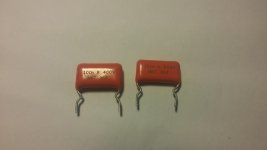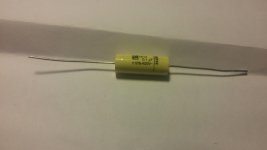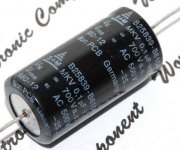Hi guys ,
I want to upgrade the coupling caps in a ST35 amp I built a few years back.
I got these NOS Vitamin Q on ebay and ordered some Auricaps as well. Before I start messing with my amp I would like to listen to your opinions about if the Vitamin Q's are even worth trying or should I just wait for the Auricaps to arrive.
These are the Vitamin Q
They measure fine (.1uF), I just wonder if these NOS usually go bad or I can trust them... I just want to mess with the amp as little as posible...
Thanks in advance for your help.
Cheers
I want to upgrade the coupling caps in a ST35 amp I built a few years back.
I got these NOS Vitamin Q on ebay and ordered some Auricaps as well. Before I start messing with my amp I would like to listen to your opinions about if the Vitamin Q's are even worth trying or should I just wait for the Auricaps to arrive.
These are the Vitamin Q
They measure fine (.1uF), I just wonder if these NOS usually go bad or I can trust them... I just want to mess with the amp as little as posible...
Thanks in advance for your help.
Cheers
Attachments
A quick bit of Googling tells me that Vitamin Q caps are paper in oil. I would avoid, as paper-based caps usually become leaky due to water ingress. You may be fortunate, as the correct value suggests that this has not yet happened (the cap value tends to rise as water gets in, as water has a high permittivity).
Those caps appear to be constructed for decoupling duty.
'Upgrading' coupling caps rarely makes any difference, unless wholly unsuitable or faulty caps were originally used.
Those caps appear to be constructed for decoupling duty.
'Upgrading' coupling caps rarely makes any difference, unless wholly unsuitable or faulty caps were originally used.
Thanks for your answer. Right now the caps in my amp are some generic cheap Phillips MKT or MKP, the amp sounds fine but i was hoping that better caps (I have read very good things about these Auricaps) would improve the sound even more. Is all this info i have been reading just bogus hype or do they really improve the sound in some noticeable way?
Cheers.
I might have mistaken coupling for decouping (noob here, obviously) .These go in between the voltage amplifier and power stage to block DC.
Enviado desde mi LG-D802 mediante Tapatalk
Cheers.
I might have mistaken coupling for decouping (noob here, obviously) .These go in between the voltage amplifier and power stage to block DC.
Enviado desde mi LG-D802 mediante Tapatalk
Last edited:
Blocking DC between stages is coupling. You can use those caps, but you will need to make some arrangement to connect to what was intended as a chassis clamp.
Most of the info you will have read about coupling caps is probably bogus hype. For such a cap the correct value is the most important thing - people can even get that wrong. Second is dielectric - don't use highly nonlinear high-k ceramics except in radio sets and guitar amps, but other film types are generally OK except in filter networks such as speaker crossovers. Third is build quality - normal competent commercial quality is sufficient - expensive boutique caps may sometimes be worse than this. Completely unimportant is the brand name stamped on the outside, and the price tag.
Most of the info you will have read about coupling caps is probably bogus hype. For such a cap the correct value is the most important thing - people can even get that wrong. Second is dielectric - don't use highly nonlinear high-k ceramics except in radio sets and guitar amps, but other film types are generally OK except in filter networks such as speaker crossovers. Third is build quality - normal competent commercial quality is sufficient - expensive boutique caps may sometimes be worse than this. Completely unimportant is the brand name stamped on the outside, and the price tag.
A quick bit of Googling tells me that Vitamin Q caps are paper in oil. I would avoid, as paper-based caps usually become leaky due to water ingress. You may be fortunate, as the correct value suggests that this has not yet happened (the cap value tends to rise as water gets in, as water has a high permittivity).
Those caps appear to be constructed for decoupling duty.
'Upgrading' coupling caps rarely makes any difference, unless wholly unsuitable or faulty caps were originally used.
I've been using Russian K40Y-9 PIO caps, I guess partially because they're pretty cheap (a couple bucks per cap), and because they seem well constructed. They're glass sealed in a metal body. Is leaking still potentially a problem for them even with this construction type?
Thanks man, your answers sound so backed up by logic and knowledge that I just feel like I threw $50 down the drain... I guess I'll just leave the amp alone for now... lesson learned
Well, to be fair, I think those Auricaps are pretty good quality caps.. As far as construction is concerned and all that, so I would say at least you can still use them.. I wouldn't just toss them in the bin or something.
generic cheap Phillips MKT or MKP
Those can actually be very good, especially if those caps are labeled MKP, which means metalized polypropylene film construction.
I recently replaced some old German-made WIMA MKP caps with caps that were supposedly better-sounding. (I needed to go down in uF value.) Those WIMA MKP caps sound fine -- really. Those Philips capacitors you have might be just as good. Can you post pictures of them?
--
Last edited:
Member
Joined 2009
Paid Member
I recently had the chance to compare MKP with Russian paper-in-oil. The MKP was more neutral - but I preferred the sound with the K40Y Paper-in-oil and since the amplifier is for me, that it was I used in the end. Depending on the amplifier one may be preferable over the other - only your ears will know.
"MKT" means metalized polyester (or 'mylar'). That's not as deluxe as metalized polypropylene ('MKP').
The ERO/Roederstein 1813 are also MKT/metalized polyester, so not as deluxe as an MKP type. However, I've tried something similar and they do 'sound good' in circuit as a coupling cap.
Metalized polypropylene (MKP) is a technically better material for making capacitors than metalized polyester (MKT). Please read this article from Vishay about film capacitors:
http://www.vishay.com/docs/26033/gentechinfofilm.pdf
It does not go into opinions of what 'sounds better' than what. It is a purely factual document about capacitor types. Much more informative than any ad copy from an audiophool capacitor seller.
--
PS - I've used vintage Vitamin Q caps for output coupling in a preamp. They are not as technically good as a modern polypropylene film cap, but they absolutely do 'sound good.' I completely agree with Bigun about the sound of paper-in-oil capacitors. They have a sort of 'round' and smoothed over sound to them (hard to describe). Some have claimed that these PIO caps don't 'ring' with the signal (better damping) like plastic film caps do. I'm not sure about any of that.
--
The ERO/Roederstein 1813 are also MKT/metalized polyester, so not as deluxe as an MKP type. However, I've tried something similar and they do 'sound good' in circuit as a coupling cap.
Metalized polypropylene (MKP) is a technically better material for making capacitors than metalized polyester (MKT). Please read this article from Vishay about film capacitors:
http://www.vishay.com/docs/26033/gentechinfofilm.pdf
It does not go into opinions of what 'sounds better' than what. It is a purely factual document about capacitor types. Much more informative than any ad copy from an audiophool capacitor seller.
--
PS - I've used vintage Vitamin Q caps for output coupling in a preamp. They are not as technically good as a modern polypropylene film cap, but they absolutely do 'sound good.' I completely agree with Bigun about the sound of paper-in-oil capacitors. They have a sort of 'round' and smoothed over sound to them (hard to describe). Some have claimed that these PIO caps don't 'ring' with the signal (better damping) like plastic film caps do. I'm not sure about any of that.
--
Last edited:
A few years ago we (four music lover/diyer) did a small test: we listen different coupling capacitors in 300B SE amplifier (between driver tube and 300B gate).
Competitors (0.22uF):
Wima FKP, Vitamin Q, AuriCap, Mundorf Silver Oil, K40Y-9, Russian FT-3 teflon, V-Cap TFTF teflon.
Devices:
Systemdeck IIX turntable (Micro Seiki MA707 arm, Supex SD 900 pickup, VdH 502 cable), Hiraga prepre, AI200MM phono, 300B SE (choke loaded 5842, Lundahl 1623 OPT).
Musics:
Jazz Q, Jazz at the Pawnshop, Doors: L.A women, Mussorgsky: Pictures an at exhibition -The great gate of Kiev, Reiner RCA 1958. mono-
Unified opinion (from best to not so good):
V-Cap,..........K40Y-9, AuriCap, Mundorf, FT-3, Vitamin Q...........Wima.
The american teflon was the undoubted winner... but the price... I bought these caps.
K40-Y was the surprise (I own a few dozens), my Auricaps was truly balanced.
Mundorf was a bit bodiless, Vitamin Q was an disappointment, and Wima was.....unusable.
The russian teflon was unbroken (I use the V-Caps about 400 hours in my amplifier), thus in my opinion deserved a second chance. After 400-500 hours using is indistinguishable from V-Cap.
Now I use in my AI200MM AuriCaps, in my #26 tube preamp FT-3 parallel TFTF V-Cap, in my 300B amplifier CuFT V-Cap.
Competitors (0.22uF):
Wima FKP, Vitamin Q, AuriCap, Mundorf Silver Oil, K40Y-9, Russian FT-3 teflon, V-Cap TFTF teflon.
Devices:
Systemdeck IIX turntable (Micro Seiki MA707 arm, Supex SD 900 pickup, VdH 502 cable), Hiraga prepre, AI200MM phono, 300B SE (choke loaded 5842, Lundahl 1623 OPT).
Musics:
Jazz Q, Jazz at the Pawnshop, Doors: L.A women, Mussorgsky: Pictures an at exhibition -The great gate of Kiev, Reiner RCA 1958. mono-
Unified opinion (from best to not so good):
V-Cap,..........K40Y-9, AuriCap, Mundorf, FT-3, Vitamin Q...........Wima.
The american teflon was the undoubted winner... but the price... I bought these caps.
K40-Y was the surprise (I own a few dozens), my Auricaps was truly balanced.
Mundorf was a bit bodiless, Vitamin Q was an disappointment, and Wima was.....unusable.
The russian teflon was unbroken (I use the V-Caps about 400 hours in my amplifier), thus in my opinion deserved a second chance. After 400-500 hours using is indistinguishable from V-Cap.
Now I use in my AI200MM AuriCaps, in my #26 tube preamp FT-3 parallel TFTF V-Cap, in my 300B amplifier CuFT V-Cap.
If you go looking for Russian PIO caps, make sure they're available in voltages higher than 200VDC. The B+ in a Dyna ST35 is up near 350V, so you absolutely need a 400V rated cap to couple to the output stage.
The part will also be quite large, so make sure it can fit in the space you have.
--
The part will also be quite large, so make sure it can fit in the space you have.
--
Last edited:
Susomora, i use the sprague vitamine Q capacitors now for 40 years and never they let me down. I also use russian K40.
But as coupling capacitor i like the vitamine Q best in tube outputbuffer stages after the dac IC or as output coupling of phono preamps. But it is my personal taste.
I never use more then one vitamine Q in a circuit. If there are more coupling caps needed i use for them cheap MKP from Wima, Clarity caps,Auricap or Mundorf.
But as coupling capacitor i like the vitamine Q best in tube outputbuffer stages after the dac IC or as output coupling of phono preamps. But it is my personal taste.
I never use more then one vitamine Q in a circuit. If there are more coupling caps needed i use for them cheap MKP from Wima, Clarity caps,Auricap or Mundorf.
Polypropylene is the way to go. That said, there are some decent polyester caps to be had too. There is zero point in going for anything expensive for coupling purposes.
If you are unhappy with the sound from your amp then it won't get better by using boutique $$$$ exotic "ear wax" or "snake oil" coupling caps.
I use ero MKT1813 and MKP1839 and MKP1845 - these are all very nice and do the job. Also wima's can be good. I know MKT1813's are polyester, but they perform very well.
If I'm feeling really flush with cash then I might spend as much as $1 on a coupling cap. The MKP1845's are a nice shade of blue, in case I think someone might look in there.
If I'm feeling like nobody will ever look in there, then I might stick in a cheap polyester cap. Good luck hearing any difference!
btw - here are some numbers for dissipation factor (DF) I recently found online, smaller is better:
Polyester (PETP) .5%
Polycarbonate .05%
Polyphenylene sulfide (PPS) .05%
Polystyrene .05-.02%
Polypropylene .025-.01%
Teflon (PTFE) .025-.01%
If you are unhappy with the sound from your amp then it won't get better by using boutique $$$$ exotic "ear wax" or "snake oil" coupling caps.
I use ero MKT1813 and MKP1839 and MKP1845 - these are all very nice and do the job. Also wima's can be good. I know MKT1813's are polyester, but they perform very well.
If I'm feeling really flush with cash then I might spend as much as $1 on a coupling cap. The MKP1845's are a nice shade of blue, in case I think someone might look in there.
If I'm feeling like nobody will ever look in there, then I might stick in a cheap polyester cap. Good luck hearing any difference!
btw - here are some numbers for dissipation factor (DF) I recently found online, smaller is better:
Polyester (PETP) .5%
Polycarbonate .05%
Polyphenylene sulfide (PPS) .05%
Polystyrene .05-.02%
Polypropylene .025-.01%
Teflon (PTFE) .025-.01%
Last edited:
>>Wima FKP, Vitamin Q, AuriCap, Mundorf Silver Oil, K40Y-9, Russian FT-3 teflon, V-Cap TFTF teflon<<
I think that there must be room for Siemens MKV (B25839)
Another nice Polypropylene! but its in oil so probably too posh for me.
- Status
- This old topic is closed. If you want to reopen this topic, contact a moderator using the "Report Post" button.
- Home
- Amplifiers
- Tubes / Valves
- Vitamin Q or Auricaps for coupling...any opinions?



